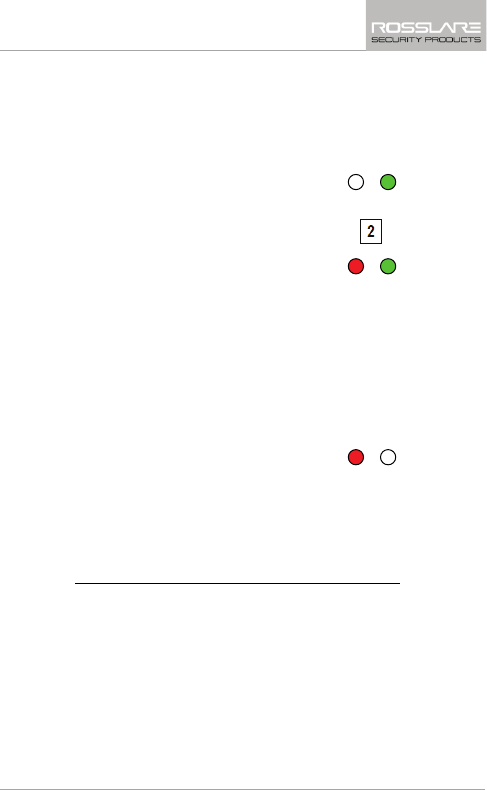User's Manual
Table Of Contents
- 1. General Information
- 2. Technical Specifications
- 3. Installation
- 4. Wiring Instructions
- 5. Reader Functionality
- 5.1 Transmit Mode
- 5.2 Programming the AYC-Ex5 and AYC-T65
- 5.2.1 Entering Programming Mode
- 5.2.2 Exiting Programming Mode
- 5.2.3 Selecting Keypad Transmission Format
- 5.2.3.1 Keypad Transmission Format Option Number
- 5.2.3.2 Option 1: Single Key, 6-Bit Wiegand (Rosslare Format)
- 5.2.3.3 Option 2: Single Key, 6-Bit Wiegand Nibble and Parities
- 5.2.3.4 Option 3: Single Key, 8-Bit Wiegand Nibbles Complemented
- 5.2.3.5 Option 4: 4 Keys Binary + Facility Code, Wiegand 26-Bit
- 5.2.3.6 Option 5: 1 to 5 Keys + Facility Code, Wiegand 26-Bit
- 5.2.3.7 Option 6: 6 Keys BCD and Parity Bits, Wiegand 26-Bit
- 5.2.3.8 Option 7: Single Key, 3x4 Matrix Keypad (MD-P64)
- 5.2.3.9 Option 8: 1 to 8 Keys BCD, Clock & Data
- 5.2.4 Selecting Proximity Card Transmission Format
- 5.2.5 Changing the Programming Code
- 5.2.6 Changing the Facility Code
- 5.3 Setting the Backlight
- 6. Controller Functionality
- 6.1 Normal, Secure, and Master Users
- 6.2 Modes of Operation
- 6.3 Auxiliary Input & Output
- 6.4 Door Alarms
- 6.5 Internal Case and Back Tamper
- 6.6 Lockout Feature (Keypad Tamper)
- 6.7 Request to Exit (REX) Function
- 6.8 Secure Application Appurtenances
- 6.9 Programming the AYC-Ex5 and AYC-T65
- 6.9.1 Entering Programming Mode
- 6.9.2 Exiting Programming Mode
- 6.9.3 Changing Lock Strike Code
- 6.9.4 Changing Auxiliary Code
- 6.9.5 Changing the Programming Code
- 6.9.6 Changing the Normal/Secure Code
- 6.9.7 Changing the Normal/Bypass Code and Door Chime Settings
- 6.9.8 Setting Fail Safe/Secure Operation, Tamper Siren and Lock Strike Release Time
- 6.9.9 Defining the Auxiliary Input and Output
- 6.9.10 Detailed Reference Guide
- 6.9.11 Setting the Lockout Feature
- 6.9.12 Setting the Backlight Behavior
- 6.9.13 Enrolling Primary and Secondary Codes
- 6.9.14 Deleting Primary and Secondary Codes
- 6.9.15 Relay Codes Assignment
- 6.9.16 Relay Code Assignment using Standard Method
- 6.9.17 Relay Code Assignment using Search Method
- 6.9.18 PIN Code Length/Factory Default Settings
- 6.9.19 Replacing a Lost Programming Code
- 6.9.20 Exiting Secure Mode if Normal/Secure Code was Lost
- A. Declaration of Conformity
- B. Limited Warranty

Reader Functionality
AYC-Ex5 and AYC-T65 Installation and Programming Manual 29
5.2.4 Selecting Proximity Card Transmission Format
The AYC-Ex5 and AYC-T65 has three different proximity card formats
to select from.
To select the proximity card reader transmission format:
1. Enter Programming mode.
2. Press “2” to enter Menu 2.
The Transmit LED turns red.
3. Enter the appropriate option number for the proxy card
transmission format that you wish to select:
Option 1: Wiegand 26-Bit
Option 2: Clock & Data
Option 3: Wiegand Card + PIN
You hear three beeps.
The Program LED turns off
and the Transmit LED turns
red.
If the Programming code is invalid, you hear a long beep and the
controller returns to Normal mode.
5.2.4.1 "Wiegand Card + PIN" Transmission Format
This unique mode is intended to let host controllers get card and
keypad data simultaneously. This option overrules the selected
Keypad Transmission Format and sends the keypad data as described
below.
After a card is presented to the AYC-Ex5 or AYC-T65, the program
LED starts to flash in green and indicates that unit is waiting for the
PIN code. If the entry of 1- to 5-digit keypad PIN code is disturbed and
no digit key or # key is pressed within 5 seconds, the keypad clears
Mode/Transmit
Door/Program
Green
Mode/Transmit
Door/Program
Red
Green
Mode/Transmit
Door/Program
Red










